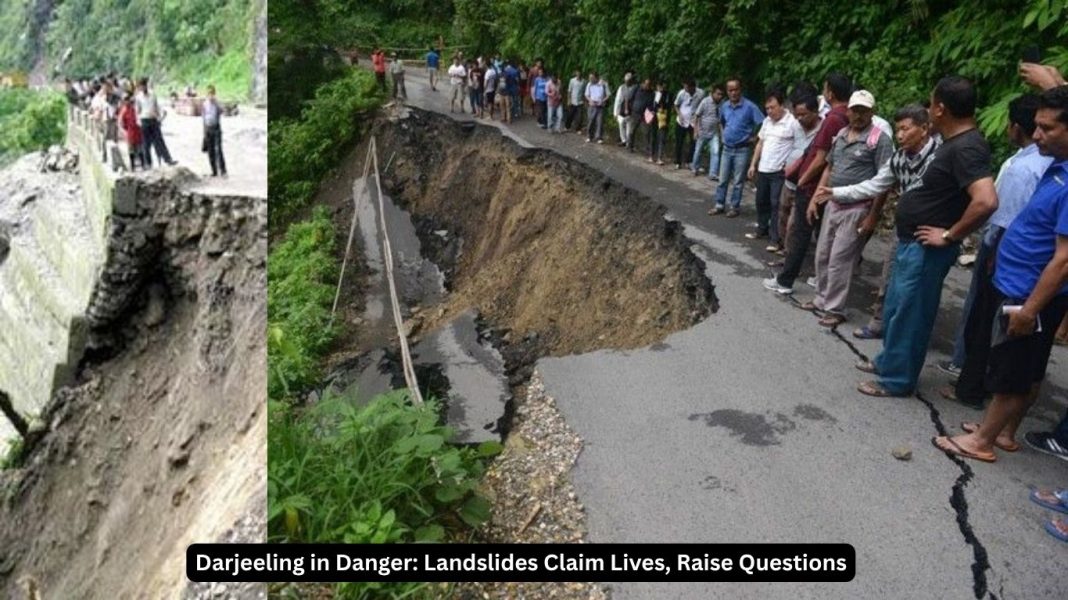Darjeeling — the “Queen of Hills” — usually makes headlines for its misty mornings, toy trains, and endless tea gardens. But recently, this paradise turned perilous as deadly landslides ripped through its slopes, leaving behind trails of destruction, grief, and hard questions.
In just a few hours of relentless rain, roads vanished, homes crumbled, and families were displaced. The region, known for its breathtaking beauty, was suddenly unrecognizable — a grim reminder that even nature’s masterpieces have breaking points.
So, what caused these tragic landslides? Was it just nature being unpredictable — or are humans slowly writing their own disaster story?
The Beautiful but Fragile Hills of Darjeeling
Perched high in the Himalayas, Darjeeling’s charm lies in its steep terrain, rich vegetation, and monsoon-fed rivers. But that very charm hides a dangerous secret — the hills are geologically young and unstable.
Think of it like living on a sandcastle: one strong wave, and the foundation gives way. The combination of steep slopes and heavy rainfall makes the area naturally prone to landslides. Add human interference, and you’ve got a recipe for disaster.
What Triggered the Recent Landslides?
This year’s monsoon has been particularly unforgiving. Record-breaking rainfall pounded the region for days, saturating the soil until it could hold no more. When the ground finally gave way, entire slopes tumbled down, swallowing everything in their path.
But rainfall alone isn’t the full culprit. Experts point to a deadly trio:
- Deforestation: Trees that once held the soil together are being cut down for roads, houses, and hotels.
- Unplanned Construction: Buildings cling to fragile slopes with little regard for geological stability.
- Poor Drainage: Water seeps into the soil instead of flowing away, weakening the slopes from beneath.
Locals took to social media to share heartbreaking images — roads disappearing overnight, cars buried in mud, and rescue workers wading through knee-deep sludge. It’s a scene that repeats every few years, only getting worse each time.
Are We Making the Hills Unliveable?
Let’s be honest — nature isn’t always to blame. Humans have been steadily pushing the limits of what the hills can handle. From expanding highways to unchecked tourism, Darjeeling’s slopes are being stretched thin.
Illegal construction has mushroomed across areas that were never meant for buildings. Tea estates have expanded into forest zones. Even small villages now have multi-story hotels catering to the rising tourist rush.
As one local environmentalist put it, “We’ve turned nature’s spa resort into a construction site — and now she’s filing a complaint.”
The Science Behind the Slides
A landslide may look like a sudden accident, but in reality, it’s a slow-motion tragedy. Layers of soil and rock, once held together by roots and moisture balance, gradually loosen. When heavy rain hits, gravity takes over.
Geologists explain that Darjeeling sits on a fragile bedrock system that can’t handle prolonged saturation. The result? Slopes start to slip, and within moments, disaster unfolds.
Interestingly, other hill regions like Sikkim and Himachal Pradesh face similar issues — but those areas have begun using satellite-based monitoring and early warning systems. Darjeeling, however, still lacks consistent landslide prediction tools and enforcement of building codes.
Lives in the Rubble: The Human Story
Behind every statistic lies a human face. Entire families have been displaced, children are missing school, and livelihoods — from tea pickers to small shop owners — have been wiped out.
Rescue teams, including the National Disaster Response Force (NDRF), worked round the clock, often battling weather and terrain. Locals too became first responders, digging through debris with bare hands to save neighbors.
One survivor from Mirik said, “We went to sleep to the sound of rain, and woke up to silence — our home was gone.”
It’s stories like these that remind us this isn’t just a natural event — it’s a humanitarian crisis.
What Can Be Done to Prevent the Next Disaster?
While we can’t stop the rain, we can stop turning rainfall into ruin. Experts suggest a combination of science, policy, and common sense:
- Strict Building Codes: Stop illegal hilltop constructions and enforce slope-safe architecture.
- Reforestation Drives: Plant trees that strengthen soil binding and reduce runoff.
- Proper Drainage Systems: Ensure rainwater is channeled away from steep slopes.
- Scientific Land Use Planning: Identify high-risk zones and restrict human activity there.
- Community Awareness: Educate locals and tourists on landslide safety and early evacuation measures.
Other countries like Japan and Norway have mastered landslide mitigation through tech-based monitoring, slope sensors, and community drills. Darjeeling can learn a lot from them — and adapt those lessons locally.
Hope on the Horizon
It’s not all doom and gloom. State authorities and local NGOs have started taking preventive steps — slope stabilization projects, warning systems, and reforestation initiatives are slowly picking up pace.
Darjeeling has seen countless challenges — from earthquakes to political turmoil — yet it always finds a way to rise again. With the right blend of technology, governance, and public participation, these hills can heal.
Conclusion: A Wake-Up Call, Not a One-Time Tragedy
The deadly landslides in Darjeeling are more than just a headline — they’re a warning. A warning that progress without planning is peril.
As the clouds clear and the hills try to breathe again, one thing is clear: if we don’t respect nature’s boundaries, she will redraw them herself.
Because sometimes, the loudest message comes not in words — but in the roar of a collapsing mountain.
